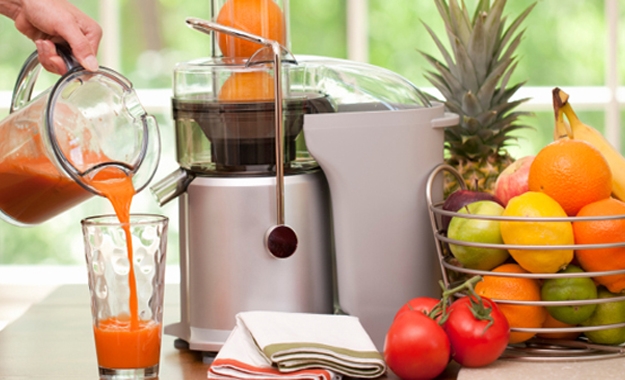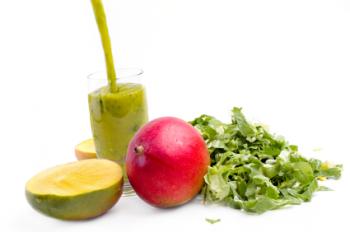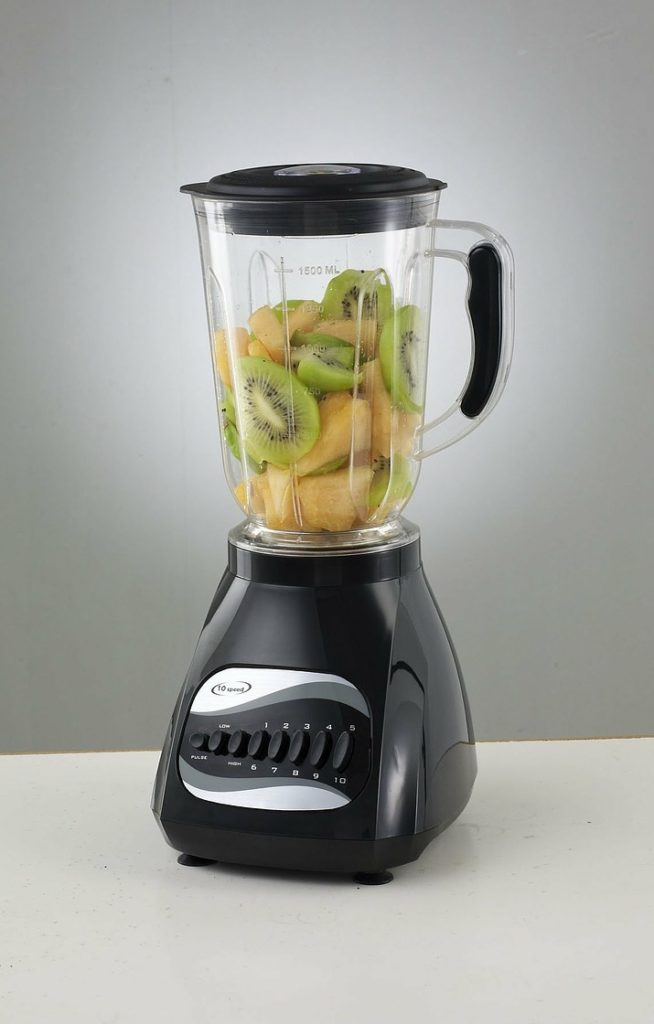Are you considering juicing or making healthy smoothies part of your diet?
If so, this article is for you, because today I’m going to examine what makes more sense: using your blender to create green smoothies or using a juicer to create juice?
The basic idea behind both blending and juicing is it’s an easier-to-digest and faster way to get more fruits and more (and a wider variety of) vegetables into your diet.
So what exactly does a juicer do?
A juicer extracts the juice from fruits and vegetables. It does so by removing the pulp (and hence the fibre) from the fruit or vegetable leaving just the nutrients.
You don’t put water or any other liquid in a juicer. Plus most juicers recommend you do not juice bananas as their starchy texture will clog the machine.

Benefits of juice made with a Juicer
Without having to deal with the fibre your digestive system doesn’t have to work as hard to break down the food and absorb the nutrients.
You can fit many fruits and vegetables i.e. nutrients into one glass.
You can use the juice you make in your Juicer as an ingredient in your smoothie.
Downside of juice made with a Juicer
Without fibre the nutrients and sugar are absorbed faster into your system which could cause a blood sugar spike.
Fibre is a good and necessary component of a healthy diet. Most people do not get enough fibre in their daily diet. So if you use a juicer, you must make sure you get the recommended amount of fibre in other areas of your diet.
Juicing doesn’t make you feel full. After juicing you may want to eat something an hour later.
If you juice mostly fruits, you run the risk of having too much sugar in your diet.
It’s more expensive to juice than make a smoothie. It takes a lot of produce to create one glass of juice.
What do you do with the pulp afterwards?
You can throw it out or use it as compost. But you can also use it when making other food. For instance, you can use fruit pulp in your smoothies. Or you could use it to add extra fibre and sweetness to muffins and bread. You can add vegetable pulp to a number of different recipes to make them tastier and healthier, such as quiche, casseroles, lasagna or soup and stews.
Tips of juicing
You have to drink the juice within 15 or 20 minutes (the sooner the better) otherwise the nutrients lose their effect.
While fruit drinks are refreshing and nutritious, to avoid ingesting too much sugar, it makes sense to keep your juicing efforts focused on green vegetables while using pieces of apple to spruce up the taste.
Benefits of Smoothies
Because the fibre is still in intact the sugar is absorbed slower into the blood stream so you’re not likely to experience a blood sugar spike.
 You can add lots of nutritious extras into your smoothie such as maca, goji berries, hemp seeds, cocoa nibs, almonds, herbs, spices protein powder, nut butters, avocado, oils and so on.
You can add lots of nutritious extras into your smoothie such as maca, goji berries, hemp seeds, cocoa nibs, almonds, herbs, spices protein powder, nut butters, avocado, oils and so on.
They keep in the fridge longer. If you put them in an airtight container a smoothie should last and retain most of its nutrients for up to a day and a half or so. Although, if you’re adding protein powders to the smoothies they really need to be consumed immediately or the nutritional properties of the protein breakdown.
They fill you up. When there is fibre involved food stays in the stomach longer making you feel full longer.
It’s easier to disguise the taste of vegetables you might not care for in a smoothie than in a glass of juice.
Kids are generally more open to drinking a smoothie than drinking juice.
Downside of smoothies
Not a huge con for most people, but, compared to juicing, smoothies make your digestion system work a little harder because it has to separate the fibre from the nutrients.
Because fibre remains in the drink, you have to drink more smoothie than juice to get the same amount of nutrients.
 Benefits of a Blender versus a Juicer
Benefits of a Blender versus a Juicer
Blenders are less expensive and easier to clean than Juicers.
A blender is more versatile than a juicer. You can also use a blender to make salsa, guacamole, cocktails, soup, hummus and dip etc.
You can put everything that’s edible into a blender, leaves stems, skin, seeds etc into a blender.
Conclusion
Using a blender is sufficient for most people. Smoothies are more filling and you generally get more bang for your buck when it comes to buying ingredients. They are also easier to clean than juicers. I personally use the “Magic Bullet” blender. It’s got a really powerful little motor and they’re just really handy, don’t take up too much space and always travel with me when I’m away from home for more than a day!
Juicers are ideal for anyone who is experiencing digestion problems or can’t tolerate pulp. If you do chose to juice, it makes sense for health reasons to do so with the intent of juicing more vegetables than fruit. Having a juicer is comparable in a way to owning a dog. You should only invest in one if you’re prepared to pay attention to it and take care of it. Otherwise it could wind up sitting silent in the back of your cupboard a few months after you buy it.
Check out one of my favourite smoothies here!
